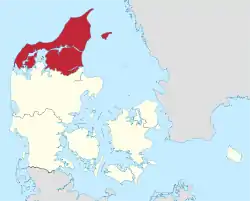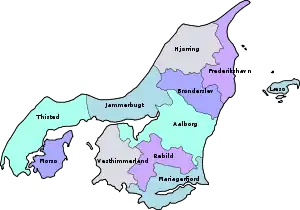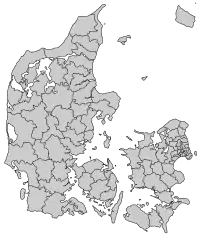North Jutland Region
The North Jutland Region[3][4] (Danish: Region Nordjylland), or in some official sources, the North Denmark Region,[5] is an administrative region of Denmark established on 1 January 2007 as part of the 2007 Danish Municipal Reform, which abolished the traditional counties ("amter") and set up five larger regions. At the same time, smaller municipalities were merged into larger units, cutting the number of municipalities from 271 before 1 January 2006, when Ærø Municipality was created, to 98. North Jutland Region has 11 municipalities. The reform was implemented in Denmark on 1 January 2007.The reform diminished the power of the regional level dramatically in favor of the local level and the central government in Copenhagen.
North Jutland
Region Nordjylland | |
|---|---|
 Flag | |
 | |
| Country | Denmark |
| Capital | Aalborg |
| Municipalities | |
| Government | |
| • Chairman | Ulla Astman (Social Democrats) |
| Area | |
| • Total | 7,933 km2 (3,063 sq mi) |
| Population (2018)[1] | |
| • Total | 589,148 |
| • Density | 74/km2 (190/sq mi) |
| Time zone | UTC+1 (CET) |
| • Summer (DST) | UTC+2 (CEST) |
| HDI (2017) | 0.914[2] very high · 4th |
| Website | www.rn.dk |
Geography
The North Jutland Region consists of the former North Jutland County combined with parts of the former Viborg County (the former municipalities of Aalestrup Municipality, Hanstholm Municipality, Morsø Municipality, Sydthy Municipality, Thisted Municipality), and the western half of Mariager Municipality (in the former Aarhus County).
Geologically the region lies in the northern part of Denmark which is rising because of post-glacial rebound.
Municipalities

The region is subdivided into 11 municipalities:
Economy
The Gross domestic product (GDP) of the region was 26.1 billion € in 2018, accounting for 8.7% of Denmarks economic output. GDP per capita adjusted for purchasing power was 33,200 € or 110% of the EU27 average in the same year.[7]
Culture and education
One of Denmark's five universities, Aalborg Universitet, is situated in the region. Most of the region's museums are situated in Aalborg such as Nordjyllands Historiske Museum, KUNSTEN, Musikkens Hus, Utzon Center and Zoologisk Have.
Regional Council
The five regions of Denmark each have a regional council of 41 members. These are elected every four years, during the local elections.
| Election | Party | Total seats |
Elected chairman | |||||||||||||||||||||||||||||||||||||||||||||||||||||||||||||||||||||||||||||||||||||||||||||||
|---|---|---|---|---|---|---|---|---|---|---|---|---|---|---|---|---|---|---|---|---|---|---|---|---|---|---|---|---|---|---|---|---|---|---|---|---|---|---|---|---|---|---|---|---|---|---|---|---|---|---|---|---|---|---|---|---|---|---|---|---|---|---|---|---|---|---|---|---|---|---|---|---|---|---|---|---|---|---|---|---|---|---|---|---|---|---|---|---|---|---|---|---|---|---|---|---|---|---|
| A | B | C | F | I | K | O | V | Ø | ... | |||||||||||||||||||||||||||||||||||||||||||||||||||||||||||||||||||||||||||||||||||||||||
| 2005 | 20 | 1 | 2 | 2 | 1 | 2 | 12 | 1 | 41 | Orla Hav (A) | ||||||||||||||||||||||||||||||||||||||||||||||||||||||||||||||||||||||||||||||||||||||||
| 2009 | 17 | 1 | 4 | 4 | 3 | 12 | Ulla Astman (A) | |||||||||||||||||||||||||||||||||||||||||||||||||||||||||||||||||||||||||||||||||||||||||||
| 2013 | 16 | 1 | 3 | 2 | 1 | 4 | 12 | 2 | ||||||||||||||||||||||||||||||||||||||||||||||||||||||||||||||||||||||||||||||||||||||||||
| 2017 | 18 | 1 | 4 | 1 | 4 | 11 | 2 | |||||||||||||||||||||||||||||||||||||||||||||||||||||||||||||||||||||||||||||||||||||||||||
| Data from Kmdvalg.dk | ||||||||||||||||||||||||||||||||||||||||||||||||||||||||||||||||||||||||||||||||||||||||||||||||||
See also
References
- FOLK1: Population 1 October database from Statistics Denmark, www.statistikbanken.dk
- "Sub-national HDI - Area Database - Global Data Lab". hdi.globaldatalab.org. Retrieved 13 September 2018.
- "Official Tourist information – Welcome to North Jutland!". www.visitnordjylland.com. Archived from the original on 7 July 2019. Retrieved 29 April 2018.
- "Danish state authorities". www.statsforvaltning.dk. Archived from the original on 27 March 2008. Retrieved 12 October 2009. use both the Danish name Region Nordjylland and the direct translation North Jutland Region in English texts. The latter is also widely used by others, e.g. by the former Region Council Chairman.
- The North Denmark Region www.rn.dk, accessed 2 January 2021
- Danmarks Statistikbank www.statistikbanken.dk, accessed 2 January 2021
- "Regional GDP per capita ranged from 30% to 263% of the EU average in 2018". Eurostat. 5 March 2020. Retrieved 2 January 2021.
External links
![]() North Jutland travel guide from Wikivoyage
North Jutland travel guide from Wikivoyage
- Official website (in English)
 Media related to Region Nordjylland at Wikimedia Commons
Media related to Region Nordjylland at Wikimedia Commons

.svg.png.webp)